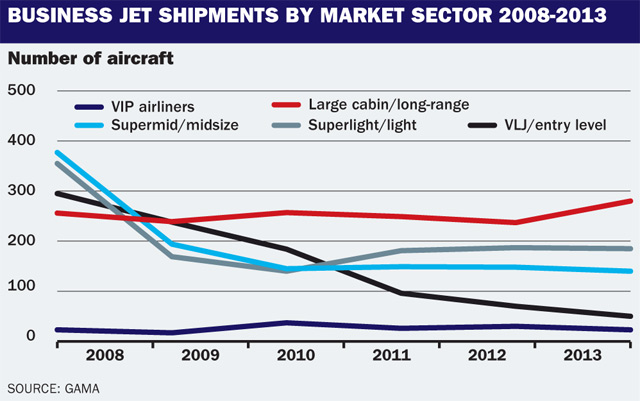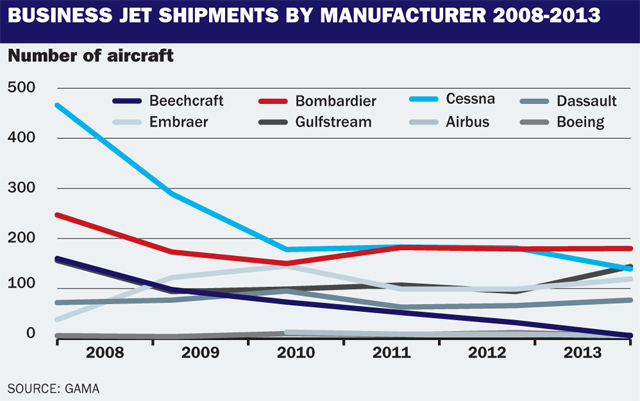The business jet industry has recorded its first increase in annual shipments for five years, fuelled almost single-handedly by the booming large-cabin, long-range segment, which smashed its yearly delivery record in 2013, according to the latest figures from the General Aviation Manufacturer’s Association (GAMA).
Released on 19 February, the GAMA data shows that business jet shipments climbed from 672 aircraft in 2012 to 678 last year – a modest increase of around 1%. Although the tally is well below the 1,145 shipments recorded during the market’s 2008 peak, deliveries of large-cabin and long-range aircraft hit record levels over the last 12 months. According to GAMA, 280 top-of-the-range business jets (excluding modified airliners) were shipped in 2013 – compared with 256 in 2008 and 237 in 2012.

STRONG PERFORMERS
Gulfstream had a very strong year, delivering 121 aircraft in its large-cabin, long-range family – including the first of its flagship G650s – compared with 94 in 2012. Although Gulfstream does not separate out the performance of individual models, Flightglobal’s Ascend Online Fleets database clearly shows the impact of the G650’s ramp-up on its handover total last year. The Ascend data records deliveries of 41 G650s, 47 G550s and 33 G450s during the period.
Bombardier, meanwhile, saw deliveries of its large-cabin Challenger 605, super-large Global 5000 and long-range Global 6000 climb from 88 in 2012 to 94 last year. Dassault saw its shipment tally of twinjets and trijets climb from 66 to 77 during the same period, including a record 43 long-range 7Xs. The French airframer also delivered the first three examples of the Falcon 2000LXS – an aerodynamically enhanced follow-up to the 2000LX.
GAMA president Pete Bunce attributes the rise in large-cabin jet deliveries to a growing number of corporations requiring long-distance travel. “Companies are using long-range aircraft in increasing numbers to connect to world’s booming economies, such as China – where face-to-face meetings are a vital part of any business transaction,” he says.
“These aircraft also provide unrivalled versatility for companies that need to travel to multiple locations and remote destinations, such as in Africa.” new programmes. Such is the appetite for top-end traditional business jets that delivery positions are creeping further and further back. The next available slot for a G650, for example, is currently almost four years away.

STRUGGLING SECTORS
The contrast with the performance of the lower half of the business jet sector, however, could not be more stark.According to GAMA’s data, shipments of light and superlight business jets have fallen from a peak of 355 in 2008 to 185 last year, itself barely an increase over the 183 recorded in 2012.The midsize sector has also fared badly over the same period, with 355 jets shipped in 2008, 148 in 2012 and only 140 last year. The poor performance of the light and midsize sectors in recent years was behind Beechcraft’s decision in 2012 to ditch its Hawker business jet family and concentrate solely on manufacturing propeller aircraft.
“It has certainly been a struggle at the lower end of the spectrum,” Bunce says. “Sales into established markets – USA and Europe – have suffered due to the fragile economies,” he adds.
“Although traditional buyers [such as medium and large] companies have built up significant cash reserves there is too much economic uncertainty and they are unwilling to commit to purchasing an aircraft.”Bunce says the “bellwether for growth” is defined as three consecutive quarters of GDP growth at 3%. “We hang our hat on this economic model, but it hasn’t happened yet,” he says.
NEW PROGRAMMES
As the market waits for a full recovery, business jet manufacturers have continued to launch new or upgraded programmes. Last year marked the first deliveries of a handful of new models. Bombardier shipped 18 Learjet superlight/light Learjet 70/75s in the fourth quarter, replacing the poorly performing 40/45 in service. During the same period, Cessna handed over a dozen superlight Citation M2s along with 13 Sovereign+ midsize jets – an upgraded version of its ten-year-old Sovereign. Dassault delivered the first 2000S in the second quarter and ended the year with 12 of the new super midsize twinjets in service.
And 2014 will see the service entry of a handful of new and upgraded designs, namely the super midsize Challenger 350, the high-speed Citation X+, the midsize Learjet 85 and Embraer Legacy 500 as well as the light cabin HondaJet HA-420. “Across the business and general aviation spectrum the signs are positive, fuelling cautious optimism for the industry in 2014,” Bunce says.
GAMA’s 2013 shipment data illustrates his point. It records 2,256 business and general aviation aircraft deliveries during the period – a 4.3% increase on 2012’s figure of 2,164 aircraft. Strikingly, last year’s deliveries yielded a $23.4 billion book value – a 24% rise over the previous year, and the second-largest billings tally since 2008 when it hit $25 billion.

TURBOPROP SECTOR
Surprisingly, perhaps, the turboprop sector saw the sharpest increase in delivery numbers with 645 single- and twin-engined types delivered in 2013 – 10.4% more than the previous year. This sector is experiencing a renaissance as demand for fuel-efficient, versatile, multi-mission types rises. Beechcraft, Daher-Socata and Piper recorded the highest delivery numbers since 2009 for their respective King Air, TBM 850 and Meridian models, and Quest Aircraft saw shipments of its Kodiak turboprop single attain a record high.
Meanwhile, the growing global market for flying training propelled piston-engined aircraft shipments from 908 units in 2012 to 933 units last year – the highest for two years – which included the first 21 Cessna TTx high-performance singles. “It is still a shadow of what it was in the 1970s and 1980s. I would love to see the piston-engined market more robust than it is,” says Bunce.
He is confident the Small Airplane Revitalisation Act, passed into US law last year, will help to re-energise the lighter end of the market (up to 5,700kg) as it increases an element of proportionality into the regulations. “The light aircraft segments have suffered in terms of new product innovation as a result of overly prescriptive and rigid rules,” says Bunce. “These measures should help cut certification costs.” ■
Source: FlightGlobal.com
















